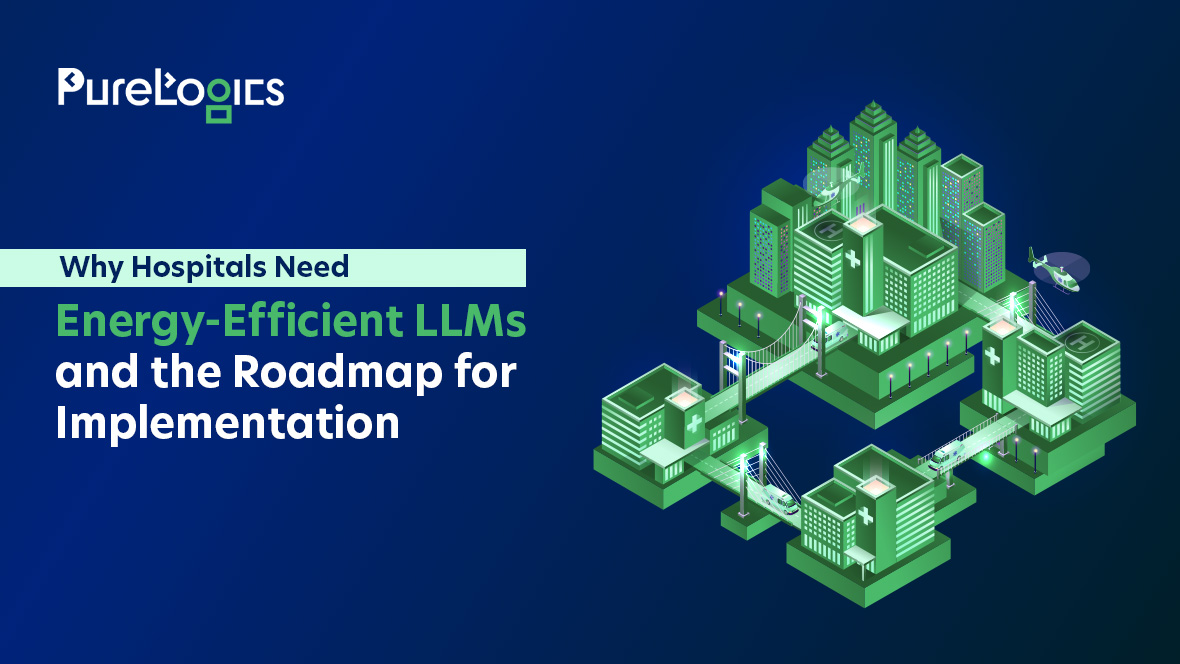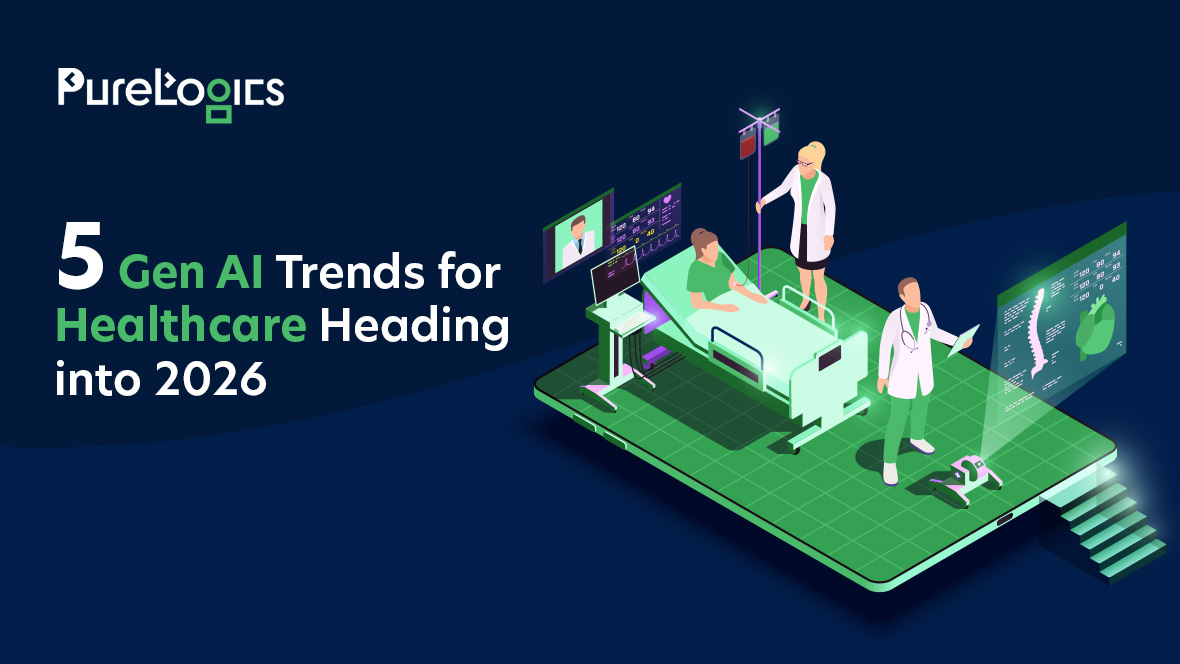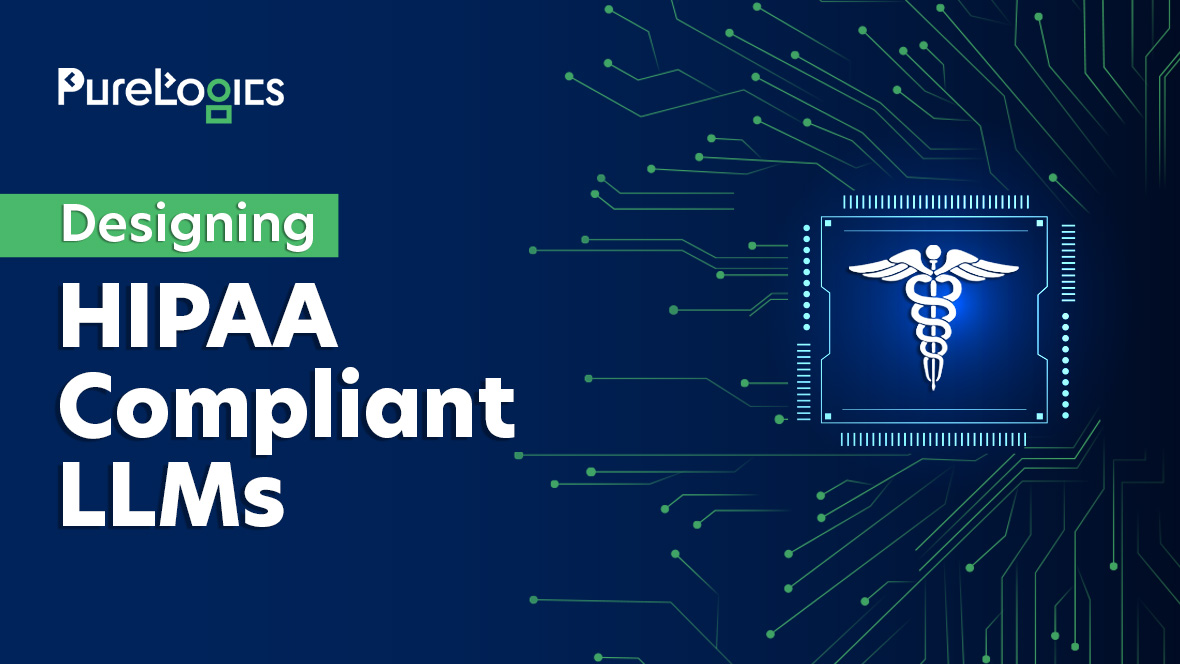Revenue Cycle Management (RCM) serves as the financial backbone of healthcare organizations, directly impacting the patient care quality, operational effectiveness, and overall financial health. It encompasses all economic processes, from patient registration to the final payment of all bills. Moreover, with the surge of telehealth, stricter CMS (Centers for Medicare & Medicaid Services) guidelines, and the increasing shift towards value-based care, efficient revenue cycle management has become more critical than ever. Additionally, due to inefficiencies and outdated revenue management systems, the healthcare organizations are literally bleeding money.
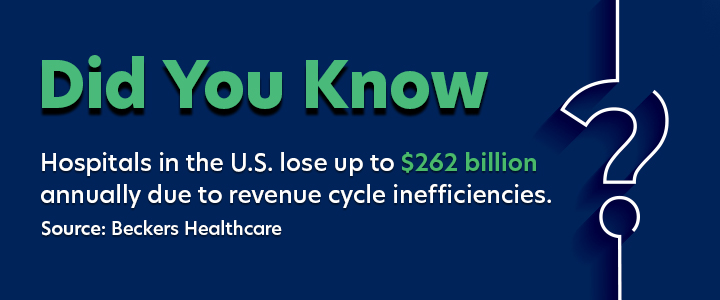
In addition to financial issues, inefficient revenue management can create compliance and regulatory problems, ultimately tarnishing the hospital’s image and potentially leading to legal repercussions. However, the healthcare revenue cycle management software has proved to be effective. Let’s see some of the common challenges healthcare facilities can face without them.
Challenges for Healthcare Facilities Without RCM
According to HFMA, nearly 9% of hospital claims are initially denied, costing providers an average of $118 per claim. Moreover, the healthcare businesses without RCM face revenue loss, billing inefficiencies, operational strain, and other challenges, as given in the image below.
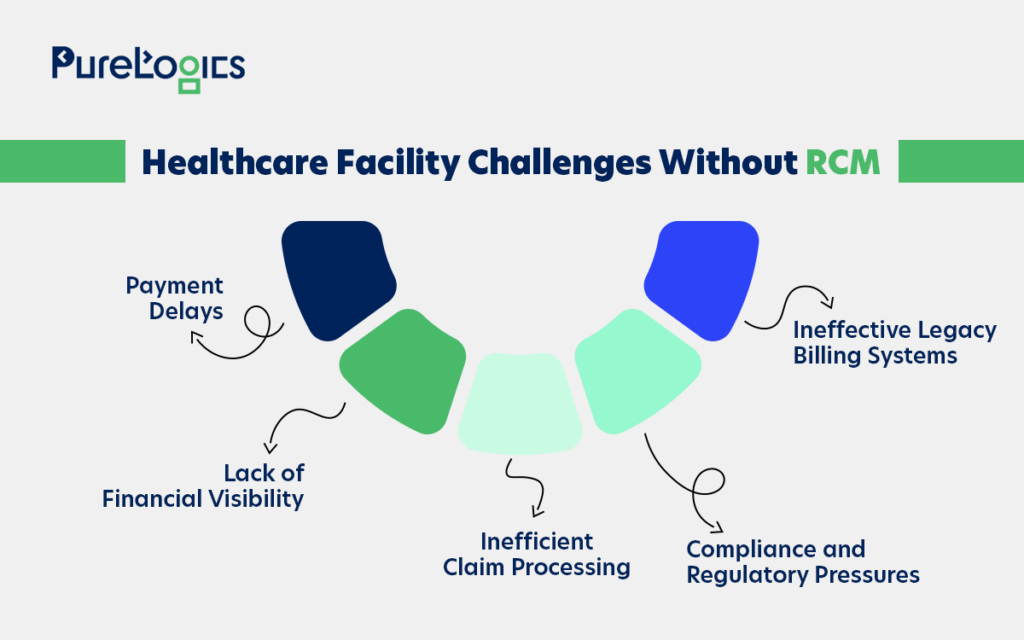
The revenue cycle is not only limited to financial management, but also includes compliance aspects and the protection of patient data. Let us explain these challenges in more detail.
- Payment delays: Insurance deductibles make it more challenging for healthcare providers to collect payments from their patients. Additionally, the communication channels are limited; here, the RCM tools can improve patient engagement via digital reminders, self-service portals, and flexible payment options.
- Lack of financial visibility: Legacy reporting systems often fail to provide real-time visibility into an organization’s financial health. This results in missing revenue-generating opportunities, whereas the modern Revenue Cycle Management (RCM) platforms offer live dashboards and analytical tools that provide effective oversight into operational finances.
- Inefficient claim processing: Manual data entry, incomplete documentation, and legacy systems often result in claim denials and rework, leading to financial shortfalls and placing excessive strain on staff resources. RCM software streamlines the claim validation, recognizing gaps or missing information early in the workflow, and helps decrease the denial rates.
- Compliance & regulatory pressures: Non-compliance with healthcare regulations and challenging billing codes (such as modifications to ICD-10 codes) can result in audits and penalties. Therefore, RCM software can help maintain compliance by providing rules for updates and incorporating automated compliance checks into its workflow.
- Ineffective legacy billing systems: These systems hinder revenue cycle management by relying on manual processes, limiting automation, and slowing billing workflows. Moreover, poor integration with the hospital system causes fragmented operations, while a lack of validation tools increases claim denials and compliance risks. The modern RCM solutions overcome these challenges by automating workflows, reducing claim denial rates, and ensuring compliance.
These challenges are complex to overcome for any healthcare facility, mainly because they impact multiple aspects of operations. Additionally, manual processes and legacy systems can introduce inefficiencies that are difficult to rectify. But revenue cycle management software can help mitigate these challenges with its numerous benefits. First, it is better to understand what RCM software is.
What Is Revenue Cycle Management Software?
Revenue cycle management (RCM) software is a system that streamlines the entire revenue cycle. It helps complete the revenue process, beginning with patient appointment scheduling and continuing through to final payment. This ensures the hospital’s precise billing, prompt claim submission, efficient collection, and maximized revenue. In short, RCM supports the steady cash flow, allowing the reinvestment in advanced technology, reducing errors, and enhancing care. That’s why there is a high demand for healthcare revenue cycle management software development.

The reason behind the popularity of the RCM software is the ease it provides to healthcare providers, mainly due to its customized features according to their unique needs and budgets.
Must-Have Features of Revenue Cycle Management Software
Below are some of the mandatory features that every RCM system should include to ensure efficient operations and optimized financial performance.
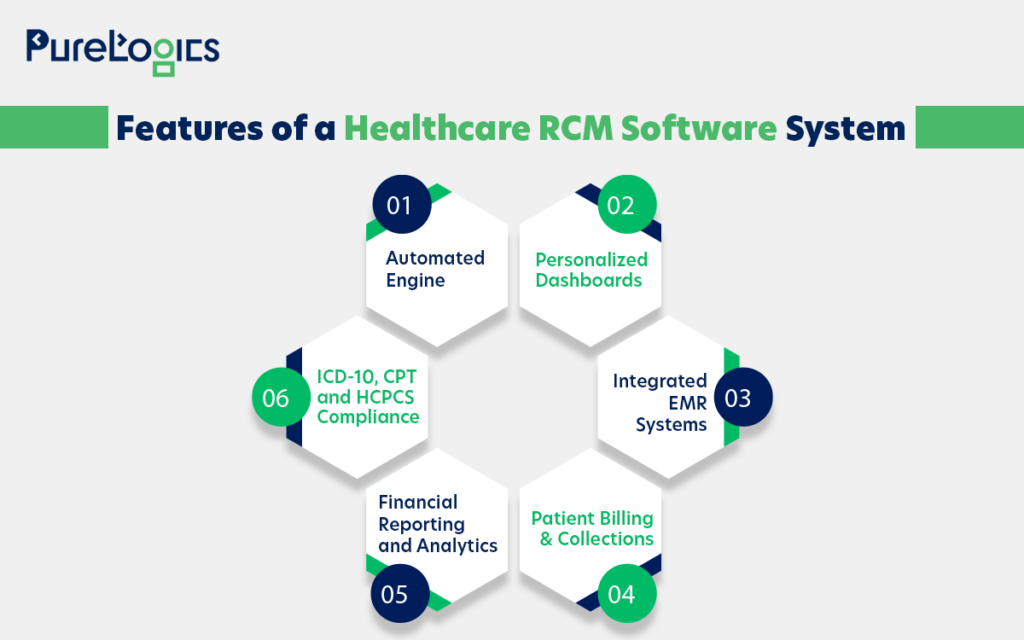
Automated Engine
A powerful automation system optimizes workflows by managing claims submission, verifying eligibility, identifying common billing errors, and sending follow-up communications. This helps reduce the likelihood of financial discrepancies before submitting claims to insurers, thereby increasing the chances of approval on the first submission.
Personalized Dashboards
Modern RCM solutions must show metrics according to the unique needs of each healthcare provider. This includes customizable dashboards and detailed operational metrics to track performance indicators, such as denial and collection rates, as well as the number of days in accounts receivable.
Integrated EMR Systems
Isolated data presents significant challenges in managing financial operations; however, revenue cycle management enables the smooth integration with Electronic Medical Records (EMR) systems, allowing for the automatic import of patient records into these systems. This helps eliminate manual data entry errors, ensuring a smooth and automated flow of patient information for accurate billing and financial management.
Patient Billing & Collections
RCM encompasses patient registration, insurance verification, claim submissions, patient billing, and collections. This includes creating patient statements and managing payment collections.
Financial Reporting & Analytics
Revenue cycle management software provides a comprehensive financial view by detecting billing errors and ensuring claim accuracy, while also highlighting revenue-impacting issues. This helps improve cash flow predictability.
ICD-10, CPT & HCPCS Compliance
RCM must facilitate the accurate documentation and coding of medical services using current coding standards, such as ICD-10, CPT, and HCPCS codes, to ensure correct billing.
Due to these features, the revenue cycle software delivers significant benefits, including enhanced cash flow and reduced claim denials, which lead to an increase in overall operational efficiency. Let us tell you more about the benefits.
Benefits of Revenue Cycle Management Software
Here’s how the revenue cycle management software is impacting the healthcare facility’s day-to-day operations.
Maximized Claim Approvals
Medical revenue cycle management software detects billing errors and eligibility mismatches, ensuring that the claims are clean before submission. This leads to higher approval rates, fewer denials, and quicker turnaround from payers.
Reduced Administrative Burden
Automation minimizes the burden of manual tasks, such as claim submission and follow-up, enabling staff to focus on patient care instead of paperwork. It is vital for improving efficiency and employee satisfaction.
Efficient Reimbursement
RCM solutions help ensure timely payments, which improves cash flow. With fewer errors and denials, providers can maintain financial stability without long delays.
Financial Transparency
The personalized dashboards give a clear view of financial revenue performance and operational KPIs. Helping them track denial rates, collection trends, and outstanding balances. This leads to more informed financial decision-making.
Data Accuracy
RCM integration with EMR systems ensures that patient data flows automatically into billing processes, eliminating manual errors. Accurate data supports reliable claims and smooth coordination across teams.
Robust Compliance
RCM strengthens the regulatory compliance by applying ICD-10, CPT, and HCPCS coding standards. This helps minimize risks during audits and enables providers to stay compliant with industry regulations while protecting revenue.
Enhanced Payment Experience
Patients receive clear and accurate billing statements that reduce confusion. Moreover, automated reminders and simplified payment options help improve collection rates. This leads to increased trust and improved patient satisfaction.
Optimized Cash Flow
Analytics and reporting highlight performance gaps and revenue leakages. This gives providers better visibility into upcoming cash flows, enabling them to plan strategically and achieve financial stability.
To effectively leverage the benefits of RCM software, the healthcare facilities must follow a process. It guides the entire revenue cycle, ensuring efficient financial and administrative operations.
Take Control of Your Revenue Cycle
Boost efficiency, reduce denials, and maximize revenue with modern RCM software.
Process of Healthcare Revenue Cycle Management Software
These solutions address the entire spectrum of RCM operations for healthcare facilities, which include:
- Pre-Registration: This is the first step that enables patients to securely submit their demographic and insurance information online before their appointment. This helps save time at check-in, minimizes errors, and speeds up the claim submission process.
- Registration: Although pre-registration gathers essential information, the registration process ensures that all mandatory details are comprehensive and complete. This step may include verifying insurance coverage and capturing any missing data to provide precise billing procedures.
- Charge capture: Medical services vary in complexity and value, and charge capture involves precisely converting the healthcare service provided during the patient visit into appropriate billing items.
- Coding: Precise coding is crucial for successful claim approval, and RCM software ensures the accurate application of medical codes for patient diagnoses and treatment procedures in accordance with established industry guidelines. This guarantees that claims are filed and handled effectively by insurance providers.
- Claim submission (via Clearing House): After proper coding is completed, claims are transmitted to the clearinghouse before being sent to insurance providers. The clearinghouse validates the claim data, checks for compliance with payer requirements, and flags errors (like missing codes or mismatched patient information). This step ensures claims are “clean” before submission, significantly reducing denials and speeding up reimbursements.
- Remittance processing: When the insurance companies send payments, they include a digital document called Electronic Remittance Advice (ERA) that contains detailed payment information. The RCM software automatically reads this digital file. It instantly updates the system by posting payments to the correct patient accounts, updating claim statuses, and calculating any remaining balances —all without requiring manual data entry. This automated process helps ensure accurate tracking of all incoming payments.
- Insurance follow-up: Revenue cycle management solutions actively monitor the progress of submitted claims, detect potential problems before they escalate, and streamline communication with insurers to ensure efficient movement of claims.
All in all, integrating a solution is not enough; it’s better to assess the trends and modify them accordingly. Below are the trends you must know that are revolutionizing RCM software development.
Trends Shaping Healthcare Revenue Cycle Management
The healthcare industry is undergoing a digital transformation, driven by shifting patient expectations, rising costs, and the growing demand for value-based care. So, below are the trends that are changing the RCM in healthcare:
- Rise AI and ML: By automating tasks such as coding, claim scrubbing, and denial management, AI and ML have enhanced the efficiency of revenue cycle management capabilities. Leading to enhanced accuracy, reduced errors, and administrative burdens.
- Value-Based care: The healthcare industry is moving towards value-based care models that prioritize care quality over volume. That’s why the modern RCM healthcare platforms are moving to support these models by monitoring and documenting quality performance indicators.
- Interoperability: Healthcare systems are now more interconnected than ever, primarily due to the increasing demand for collaborative care. That’s why the RCM software must enable providers to integrate data smoothly across different healthcare IT infrastructures, maximizing operational efficiency and leading to streamlined processes and enhanced financial outcomes.
RCM solutions have transformed the healthcare industry for the better, and we assure you that this is a one-time investment with numerous benefits.
Cost of RCM Software Development
The cost of developing a custom revenue cycle management software depends upon several factors, such as:
- System complexity
- Compliance requirements
- Integration with existing EMR/EHR platforms
- Advanced features (AI-driven analytics or automation, etc.).
If you would like to know the exact cost, please share your requirements with our team here. We have 19+ years of experience years of experience in developing custom healthcare solutions.
Why Choose PureLogics?
At PureLogics, we don’t just build software; we build solutions that fit your unique workflows, compliance needs, and financial goals. Our healthcare software development team has deep expertise in developing HIPAA-compliant software, ensuring your system is secure, scalable, and future-ready. So, turn your revenue leakages into predictable cash flows, while empowering staff to focus more on patients and less on paperwork. Check out our portfolio or book a 30-minute call with our experts.
Frequently Asked Questions
What is RCM development?
RCM development is the process of designing and developing revenue cycle management software that streamlines the financial workflow for healthcare facilities. It involves creating solutions that allow patient registration, coding, claim submission, billing, and compliance, ensuring efficient operations, reduced errors, and maximized revenue.
Is RCM software secure?
Yes, RCM software is designed with robust security frameworks to protect sensitive patient and financial data. Modern solutions use TLS 1.2/1.3 encryption for secure data transmission, and many also implement mutual TLS (mTLS) to authenticate both client and server, preventing man-in-the-middle attacks. In addition, they incorporate role-based access controls (RBAC), detailed audit trails, and are aligned with HIPAA and CMS compliance standards. These measures ensure patient privacy, data integrity, and protection against unauthorized access or breaches.
How long does it take to develop RCM?
Developing a custom RCM solution typically takes 4 to 9 months, depending on the complexity, required integrations (such as EMR/EHR), and the feature set. Larger enterprise-grade systems, which require advanced automation or analytics, may take 12 months or more to implement.


 [tta_listen_btn]
[tta_listen_btn]
 September 22 2025
September 22 2025


